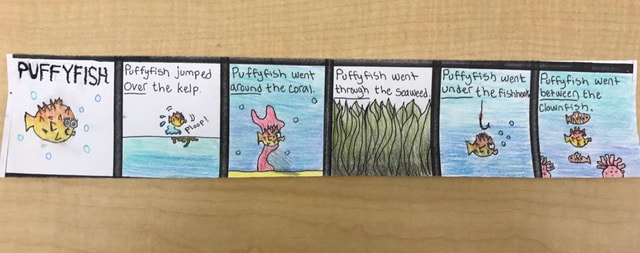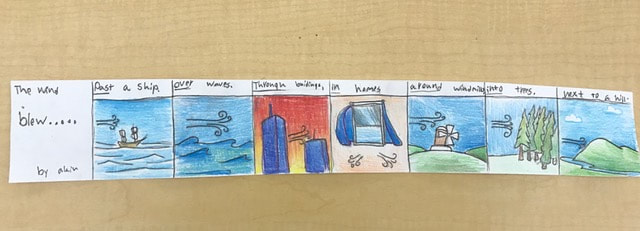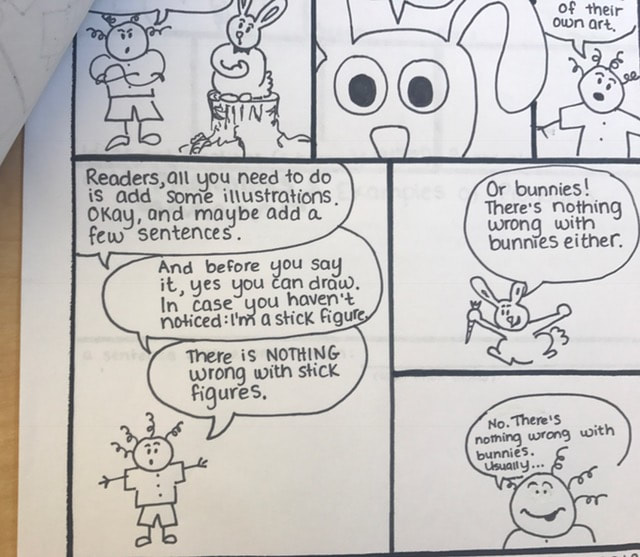|
By Samantha Davis 8th Grade Language Arts, Floyd Dryden Middle School As I began my year in Artful Teaching, I was so excited to learn new ways of integrating arts into my eighth grade language arts classroom. During a fall unit about the parts of speech, I set a goal of working art into grammar instruction, both through the products students create to show their learning and through my own teaching methods. Though I eventually added in some of the strategies I was learning about in the Artful Teaching workshops, including tableau, I primarily focused on integrating comics into the parts of speech unit. Our learning objective was for every student to show their understanding of the parts of speech through a series of mini-comics. Because I wanted to begin our learning with a form that integrated art into instruction, I created short comic books introducing students to each of the eight parts of speech. As students moved through the unit, they learned to expect that each new concept would both begin and end with a comic: they’d learn about the part of speech through a comic, and they’d eventually produce a comic showing their understanding of the part of speech. We’d start by reading a comic about the part of speech aloud in class. Voices were strongly encouraged, and the actors in class often rose to the occasion, much to their classmates’ amusement. These comics not only introduced the content-area concept, it also forced me to take the same risk I'd be asking students to take: creating and sharing original artwork. This helped create a safe environment for creating and making mistakes. After we read the introductory comic, we’d discuss the part of speech, practice identifying it in different sentences, analyze why it matters in writing, and respond to writing prompts focused on that particular part of speech. Finally, students would show their knowledge of the part of speech through their own comics. The prompts for these comics were designed to encourage creativity, provide structure, and focus on the objective. For example, one comic was called, “The Adjectives I Met Today.” For this comic, students would pick a noun and invent a variety of adjectives for that noun to “meet.” Students used the artwork to (literally) draw connections between nouns and adjectives, thus representing the abstract concept of nouns modifying adjectives in a concrete, visual way. For the students’ preposition comic strips, the prompt involved picking a noun or pronoun and an action verb. Then, every successive frame had to be a prepositional phrase. Again, students were using art to demonstrate their understanding of an abstract concept. While the prompt and the prepared templates gave even more reluctant students the confidence that they could be successful, students were encouraged to extend and adapt the prompt as well. In every class, some students would take the initial prompt in new directions, without losing their ability to demonstrate their understanding of the content goals. In these situations, students would approach me with a proposal for another approach—“What if I…”—and we’d discuss how that approach would still work to show understanding of the content goals, or we’d modify it so it would still show the understanding while honoring the student’s unique approach. Some students were reluctant about their drawing skills. But stick figures were okay: after all, the star of “Adventures in the Parts of Speech” is a stick figure. In some ways, this approach to these projects helped establish a classroom culture where the expectation is not to avoid mistakes, but to try even when we’re unsure. Finally, one of my favorite moments of this unit--and in every unit in which students produced a piece of visual art--is the moment when the student work is displayed in the back of the classroom (our classroom gallery). Without fail, the day after their work is posted, students gather to observe the creations—always searching for their own, but also seeing how others responded to the same prompt in completely different ways. Often, they’re also assessing learning and asking new questions about the concepts. In the days and weeks after I post their work, I will often find students, on their own or with their classmates, browsing the gallery. So in this final stage, students are learning from each other.
So, why was it important for students to construct and demonstrate their understanding through the arts? First of all, I found students far more ready to engage with a pretty dry concept—the parts of speech isn’t exactly the stuff of fireworks—when it was introduced in the fun, humorous, and accessible medium of comics. Furthermore, when students began creating their own comics, it allowed for on-the-spot formative assessment along with natural extensions. It was easy to see which students had a mastery of the concept and which still needed more one-on-one instruction. Plus, with students so engaged in the project, it often gave me to provide that extra instruction as soon as I identified the need for it. Even more importantly, I’ve found that the use of art to show understanding builds community in the classroom. It forges connections: students who feel more confident in their artwork can encourage and support those who feel more apprehensive about their drawing skills, while students who felt more confident about their understanding of the content concept (in this situation, the parts of speech) can question and guide those who might still be confused. Comics--whether students are reading them or creating them--invite humor and conversation. In the classroom, as students worked on their comics, there was a constant buzz of conversation as they checked their understanding and ideas with each other. While everyone created their own comic, they worked together to create, sharing and exchanging supplies—“Can I use that crayon?” “No, I’m not done with it quite yet” “Oh, here, I have one you can use”—in ways that felt natural and needed no prompting from the teacher. Similarly, students began to use the artful thinking disposition of see-think-wonder before it’d been formally introduced, as they shared their work with each other, making observations and asking questions. The work was both individual and collaborative. When I think about this question, “Why was it important for students to construct and demonstrate their understanding through the arts?”, I think about these scenes: students gathering in front of the gallery to see, think, and wonder about each other’s work; students sharing art supplies and ideas; students laughing and celebrating each individual’s unique approach to a project. In short, when students construct their learning through the arts, it encourages both individual creativity and a supportive classroom community. Though I’m in my twentieth year of teaching, my participation in Artful Teaching has consistently provided me with new challenges, ideas, and inspiration over the course of the year; I’m already looking forward to building on all I’ve learned this year with next year’s students.
0 Comments
Leave a Reply. |
ArtStoriesA collection of JSD teachers' arts integration classroom experiences Categories
All
|
|
|
Artful Teaching is a collaborative project of the Juneau School District, University of Alaska Southeast, and the Juneau Arts and Humanities Council.
|






 RSS Feed
RSS Feed